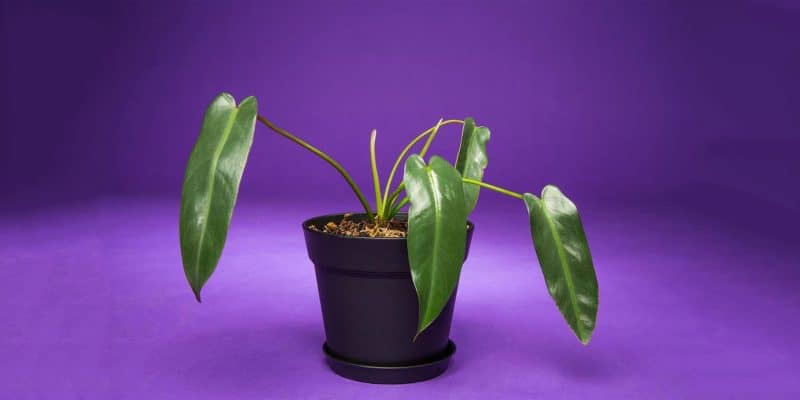Philodendron spiritus-sancti, a rare plant from South America, is the plant equivalent of the Holy Grail, and it may just be the rarest, most expensive plant that we’ve come across. With its striking elongated leaves and an air of mystique, it’s no wonder this plant is in such demand.
Let’s uncover the secrets of Philodendron spiritus-sancti care, and who knows, maybe you can even convince a few skeptical friends that there’s nothing wrong with splurging on a plant that trumps all others in rarity and elegance.
If not, there’s no harm in just taking a look . . . right?
Table of Contents
Philodendron Spiritus-Sancti Plant Care Guide
History, Habitat, and Characteristics
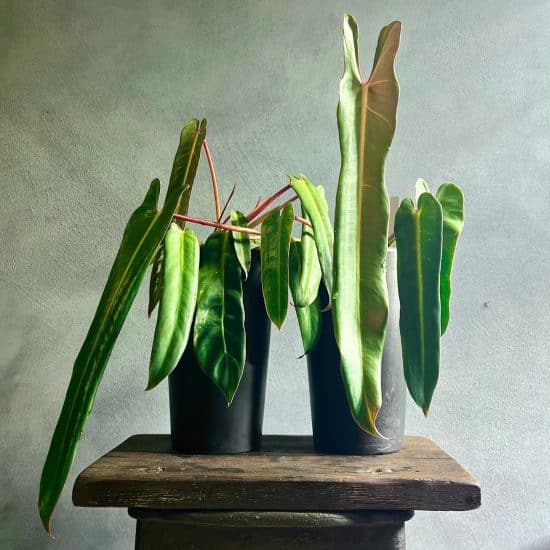
Philodendron spiritus-sancti, native to the Espírito Santo state of Brazil, has garnered a reputation as one of the most coveted and costly plants around, thanks to its striking appearance and scarcity. In addition to its divine beauty, the Philodendron spiritus-sancti boasts a unique structure and leaf pattern that set it apart from its Philodendron kin.
As the plant matures, its impressive long, narrow lance-shaped leaves resemble ancient ninja swords, developing a silvery or blue-green tint. Talk about a sharp look! When new leaves unfurl, their undersides dazzle with a bright red hue that gracefully fades over time.
Unfortunately, this plant is an endangered species. Its native habitat faces increasing threats from both deforestation and the illegal plant trade. These factors have made the Philodendron spiritus-sancti even rarer, driving up demand and price.
Caring for this celestial beauty is a rewarding challenge for fortunate plant enthusiasts. With such a rare and unique specimen, providing proper care is essential to preserving its health and exquisite appearance.
Light
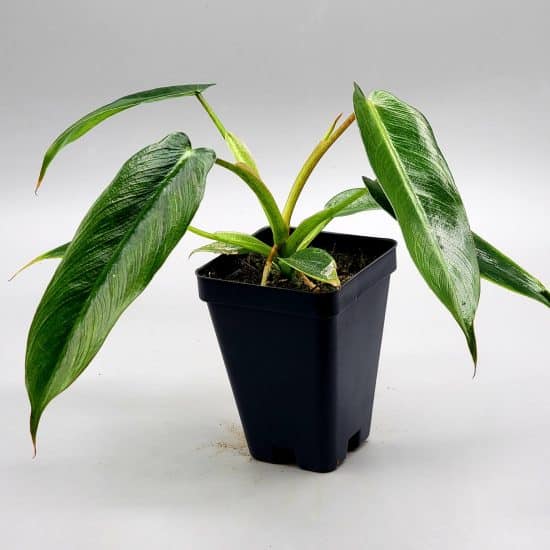
Philodendron spiritus-sancti enjoys basking in bright light but can also manage in deep shade if necessary. A few hours of direct sun in the morning is okay, but indirect light during the brighter, hotter hours of the day will protect it from scorching.
If you notice slow, leggy growth and leaves stretching out for any bit of light they can find, your Philodendron spiritus-sancti is not receiving enough light. Simply move your plant closer to a bright window or invest in a grow light.
If your Philodendron spiritus-sancti basks in too much light, its elongated triangular-shaped leaves may appear yellow, bleached, or faded, and might even develop tiny holes. This is a cry for help. To prevent further damage, move it away from direct sun or provide a sheer curtain to filter the intense rays.
Our lighting tips:
- Strike a balance with bright, indirect light to yield the best growth.
- Grow lights can be a plant’s best friend, providing just the right amount of light, especially during darker months or in rooms with limited natural light.
- Dodge too much direct light, which can wreak havoc on your Philodendron spiritus-sancti’s leaves, causing fading or small holes to appear.
Water
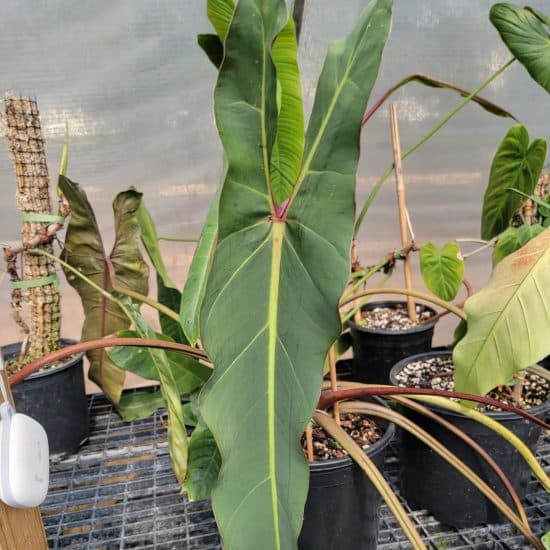
This unique plant likes to be consistently moist, but never wet. One way to achieve this is to let the top inch or two of potting medium dry out before giving your Philodendron spiritus-sancti another drink. For best results, use filtered or distilled water or treated tap water to avoid buildup of minerals and chemicals.
If your plant isn’t getting enough water, you’ll spot the oldest leaves turning a bright shade of yellow and starting to curl up. To help your plant bounce back, gradually increase your watering frequency and remove any dying leaves to encourage new growth.
On the other hand, overindulging your Philodendron spiritus-sancti in water can cause yellowing leaves and soft, mushy stems. You might also spy brown leaf tips and spots on the leaves — a telltale sign of problems caused by excess water.
In this case, pump the brakes on your watering schedule, allowing the plant to dry out more before adding more water. And always be sure to use a pot with drainage holes to avoid damage to the roots.
Temperature and Humidity
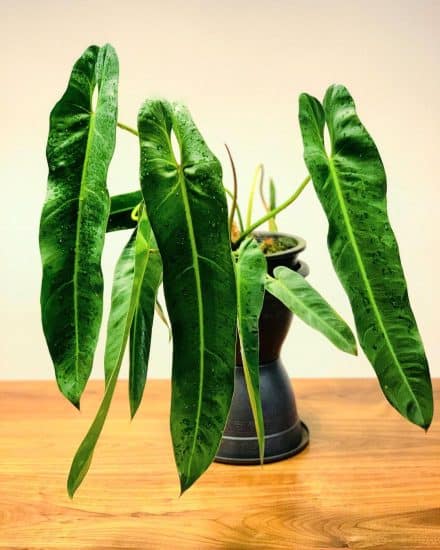
Average temperatures in Espírito Santo fall between 75°F and 85°F, so Philodendron spiritus-sancti prefers warm temperatures. It can tolerate lows of 65°F, though, so don’t worry if your home’s temperature fluctuates a bit. Just be sure to protect it from drafts and extreme temperatures, which could cause leaf damage.
To mimic its native conditions, provide your Philodendron spiritus-sancti with ideal humidity above 65% for lush, vibrant leaves. However, it can grow in 40% to 60% humidity if necessary. Curled, dry, or browning leaves might signal a lack of humidity, while excess humidity could lead to yellowing leaves and an increased risk of diseases, such as fungal infections.
To raise humidity:
- Position your plant on a tray of pebbles and water (but keep the pot out of the water to avoid soggy roots).
- Cluster your Philodendron spiritus-sancti with other humidity-loving plants, such as Monstera adansonii or Monstera obliqua, so they can share moisture through transpiration.
- Use a humidifier near the plant to maintain the desired humidity levels.
- If possible, relocate your Philodendron spiritus-sancti plant to a more humid room (like a bathroom or kitchen), but ensure it still receives adequate light.
Soil and Planting
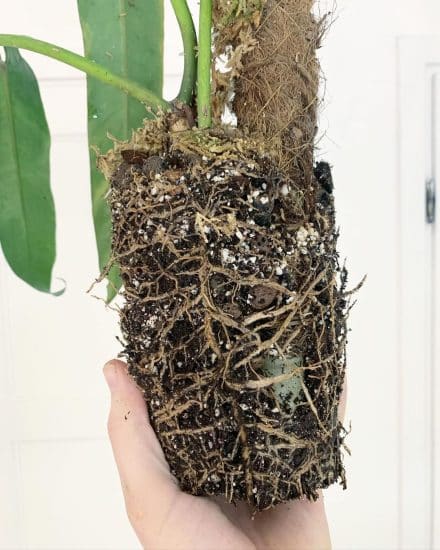
The key to a thriving Philodendron spiritus-sancti lies in providing the right soil (or rather, non-soil) and planting conditions. Focus on creating a chunky, well-aerated soilless mix that promotes proper airflow and moisture retention, imitating its natural habitat. If you do use soil, aim for an airy soil mix that includes the following ingredients:
- Charcoal. This helps with aeration and absorbs impurities within the mix.
- Coco chips. These fibrous materials from coconut husks help retain moisture while also promoting root aeration.
- Coconut coir. Like coco chips, this material comes from coconuts. It’s a moisture-retaining material that is much more eco-friendly than sphagnum moss.
- Various rocks. Perlite, pumice, or lava rocks will improve drainage and aeration within the soil, ensuring well-draining conditions.
When feeding your Philodendron spiritus-sancti, apply fish fertilizer every couple of weeks and use a slow-release, high-nitrogen fertilizer. Consistent nutrient supply encourages healthy growth.
Watch out for signs of too much fertilizer, such as yellowing leaves, burnt leaf tips, or a white crust on the soil surface. If these issues occur, lower the fertilization frequency and flush the soil with water.
Propagation
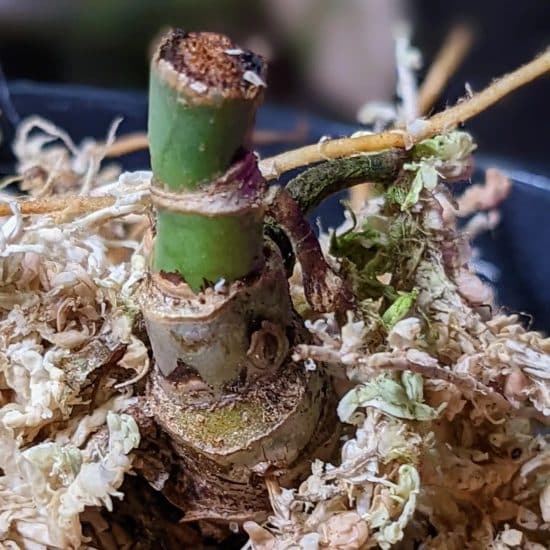
Propagating Philodendron spiritus-sancti is more than a bit tricky, but with the right technique and a bit of patience, you can successfully create new plants from your mature plant. Air layering is the most reliable method for propagating this particular plant, and we’ve got you covered with a step-by-step guide to help you through the process.
Some of the younger plants you may see are seed-grown plants, so an availability of these plants doesn’t necessarily mean it has a high success rate of propagation.
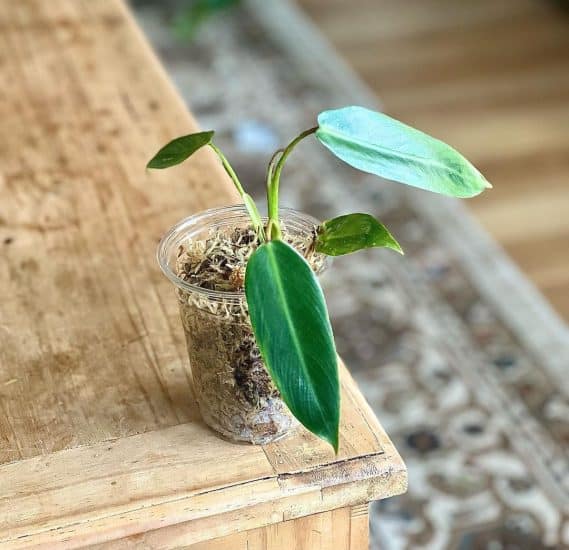
If you haven’t air-layered a plant before, or you aren’t an expert, you should know that it has a very high failure rate.
Propagating philodendron spiritus–sancti via air layering:
- Pick out the perfect stem. Find a healthy stem on your Philodendron spiritus-sancti that has at least one leaf node and looks strong, free from any damage or disease.
- Get your moss ready. Take a small amount of coconut coir and soak it in water until it’s nice and wet, but not dripping.
- Wrap that node. Locate the leaf node on the stem you’ve chosen and gently wrap the wet coir around it. Make sure the entire node is covered by the coir, so it has the best chance to develop roots.
- Bundle it up with plastic wrap. Wrap the coir-covered node in plastic wrap, sealing it tight to keep the moisture in. Be careful not to cover any leaves with the plastic, though.
- Keep an eye on the moisture. Regularly check the coir to make sure it doesn’t dry out. If it starts to look a bit dry, just take off the plastic wrap, wet it again, and re-wrap the stem.
- Watch for root growth: After waiting about a month, carefully unwrap the stem to see if roots have started to grow at the node. If you find some new roots, you’re ready for the next step!
- Snip it and plant it: Grab some sterilized shears and cut the stem just below the new roots. Plant your cutting into a well-draining mix with some orchid bark, making sure the roots are well covered. Keep the cutting in a spot with plenty of indirect light and moist soil while it gets used to its new home.
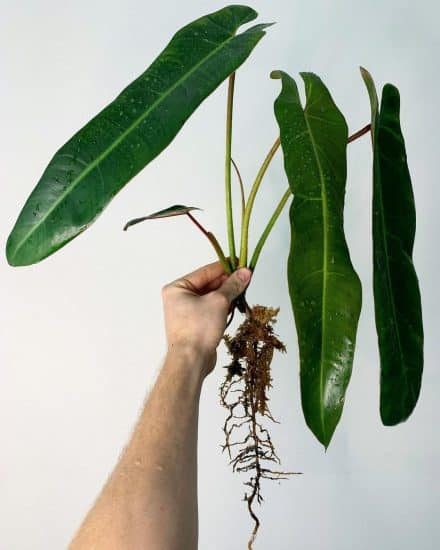
Our propagation tips:
- Make sure to use sterilized tools when cutting your plant to prevent the spread of any diseases or pathogens.
- Be gentle when unwrapping the moss and plastic, as the new roots are delicate and can be easily damaged.
- Keep a close watch on your newly potted cutting, maintaining proper watering and avoiding direct sunlight to help it settle in comfortably.
Common Issues
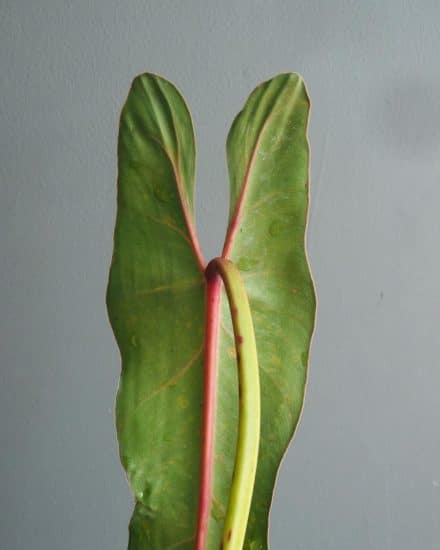
Slow Growth Rate
A slow growth rate can be a bit frustrating when you’re eager to see your Philodendron spiritus-sancti flourish. A lack of new leaves might result from inadequate light or improper fertilization.
To give your plant the energy it needs to grow, place it in a spot with bright, indirect light and fertilize with a balanced liquid fertilizer every 4-6 weeks during the growing season. Be cautious not to over-fertilize, which might cause more harm than good.
If light and fertilizer seem to be correct, really make sure your plant isn’t in an especially dry location. While Philodendron spiritus-sancti doesn’t require a terrarium, more humidity will encourage growth.
Brown Leaf Tips
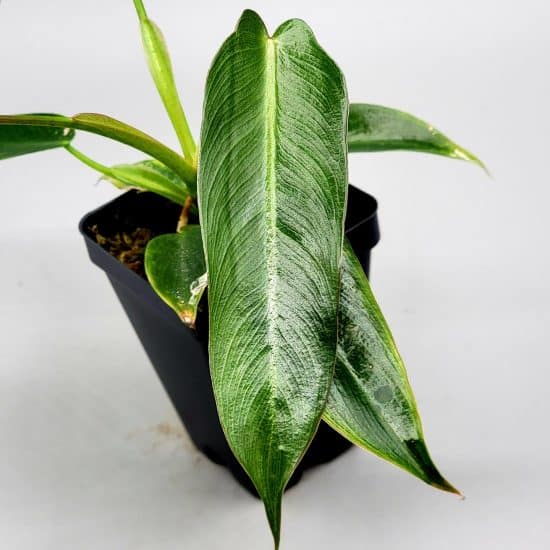
Seeing brown leaf tips on your Philodendron spiritus-sancti might be disheartening, but don’t fret! The most likely causes of brown leaf tips are low humidity and insufficient feeding.
To boost humidity, the most effective method is to use a humidifier. If moisture isn’t the issue, add fertilizer every time you water during the growing season.
Pests and Diseases
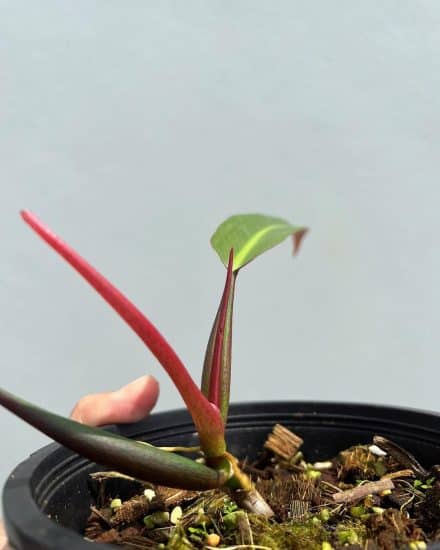
In this section, we’ll show you how to identify and fix common problems like root rot, fungus, and bug infestations.
Pests
Every now and then, your Philodendron spiritus-sancti might attract unwelcome guests like mealybugs, aphids, scale, and spider mites. These little critters can harm your plant, so it’s essential to catch and treat them early on. Keep a close eye on your plant, watching for small white bugs or webbing beneath the leaves and around the stems.
If you find any pests, isolate the plant to prevent them from spreading to other plants in your home, then gently wipe the affected areas with a damp cloth. For more severe cases, you can apply a soap insecticide or neem oil. Be sure to keep your plant out of direct sun when you’re treating it with any kind of spray, otherwise it can burn the leaves.
Root Rot
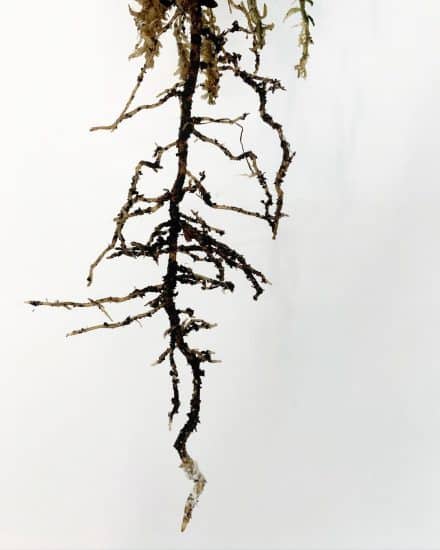
Root rot occurs when soil stays wet too long, depriving the roots of oxygen and creating anaerobic conditions. To prevent root rot, use well-draining soil and check that the soil is dry before watering. And always use a pot with drainage holes. This way, the roots won’t be waterlogged.
Should your plant develop root rot, you’ll notice telltale signs like yellowing leaves, wilting, and an unpleasant odor from the soil. To address this, gently remove the plant from its pot. Using sterilized scissors, snip away any soft, slimy, or discolored roots. Then, repot the plant into fresh, well-draining soil, and let the plant dry out before watering again.
Fungus
Philodendron spiritus-sancti may encounter fungal issues due to excessive humidity or poor air circulation. Signs of fungus are white or gray patches on leaves and stems, and sometimes even on the soil.
To tackle a fungal outbreak, separate the infected plant from other plants, carefully remove affected leaves and stems, and apply a fungicide (following the label’s directions). To keep fungus at bay in the future, improve air circulation around your plant and avoid overwatering.
Conclusion
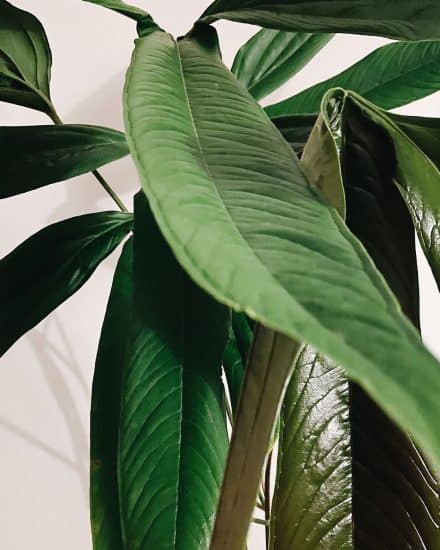
That’s a wrap for our Philodendron spiritus-sancti care guide! This rare and captivating houseplant undoubtedly deserves a special place in any indoor garden.
Philodendron spiritus–sancti care summary:
- Provide bright, indirect light, but the plant can also tolerate shade if needed.
- Allow the top inch of soil to dry out between waterings.
- Maintain humidity above 65%. Use a pebble tray, humidifier, or other methods mentioned above to achieve ideal humidity.
- Use a chunky, well-aerated soilless mix to promote root health and moisture retention.
- Apply fish fertilizer and high-nitrogen, slow-release fertilizer to encourage healthy growth.
We hope this guide has given you the knowledge and confidence you need to take on the delightful challenge of nurturing your very own Philodendron spiritus-sancti. If you have questions or need further guidance, don’t hesitate to reach out to us.
If you found this guide helpful, don’t keep it to yourself — share it with fellow plant lovers and spread the joy of caring for this extraordinary specimen.
FAQ
Why is Philodendron spiritus-sancti so expensive? How much does it cost?
There are a few reasons why this particular Philodendron is so costly, with the main factor being its rarity. This plant species is native to a small region in Brazil where the wild population is dwindling due to habitat loss.
The cost of a Philodendron spiritus-sancti can vary widely, depending on factors such as size, age, and overall condition of the plant. Young plants or cuttings may start at around $2,000 or more, while larger, more mature specimens can fetch upwards of $10,000.
These plants tend to go to serious collectors who are willing to invest in a rare and exquisite addition to their collection. If you’re just starting out with Philodendrons or houseplants in general, there are lots of other beautiful and more affordable options to consider!
What plant is similar to Philodendron spiritus-sancti?
The closest we can recommend would be Philodendron atabapoense, which has elongated, slender leaves with a burgundy underside. There’s a striking similarity when this plant is in its mature phase.
Another option is Philodendron gloriosum, which boasts large, heart-shaped leaves with striking white veins, creating a similar visual impact to the spiritus-sancti.
Another plant to consider is Philodendron mamei, which also features impressive, large leaves adorned with distinctive silvery patterns.
Both of these Philodendron varieties are more readily available and much more budget-friendly, making them an excellent choice for those who appreciate the aesthetic of the spiritus-sancti but can’t drop $10,000 on a plant.

